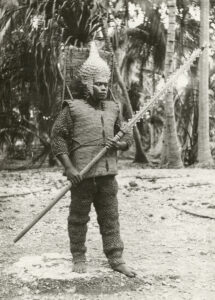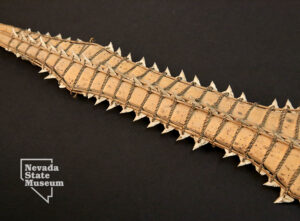May Curator’s Corner
Sharks have come a long way from the vilified man-eater portrayed in Jaws. Today, we realize that this top ocean predator helps ensure a healthy ecosystem. Some Pacific Island nations, such as Kiribati (pronounced Ki-ri-bas), recognize the importance of sharks and have created shark sanctuaries. Kiribati is located in the central Pacific Ocean, about 2,500 miles southwest of Hawaii. Kiribati consists of 33 coral islands divided among three island groups: the Gilbert Islands, the Phoenix Islands, and the Line Islands.
Sharks are culturally significant to the indigenous people of the Gilbert Islands and feature in their settlement mythology and ceremonies for boys reaching adulthood. Gilbert Islanders created shark tooth weapons, including daggers, swords, and lances, used in highly ritualized and often fatal battles into the early 20th century. Lances were the longest weapons, some measuring up to 25 feet! These formidable weapons, as well as coconut fiber armor, were collected in the mid to late 19th century by whalers, missionaries, anthropologists, and museums. A shark tooth sword, measuring 4 feet 3¾ inches long, is part of the Dr. S. L. Lee (1844-1927) collection. He was a Victorian-era collector from Carson City.
Since shark teeth are diagnostic to species, conservation biologist, Joshua Drew, thought to identify teeth on 124 shark tooth weapons at the Field Museum in Chicago. By identifying the species of sharks from these weapons, and studying historical records, Drew and his colleagues reconstructed the composition of the Gilbert Islands’ shark community in the late 19th century. They discovered that teeth from two species of shark, the dusky shark (Carcharhinus obscurus), and the spot-tail shark (Carcharhinus sorrah), had been used extensively even though they are presently found thousands of miles from the Gilbert Islands. Drew calls this, “shadow biodiversity – biodiversity that has been lost before formal scientific assessment” and published the results of the shark tooth weapon survey in PLOS One. “When we set up modern conservation plans, we shouldn’t sell ourselves short,” says Drew. “We might not recapture the vivid splendour of those super-rich levels, but this information argues for setting up management plans to protect what sharks are there.”
Curatorial Postcard from Rachel Delovio, Anthropology Collections Manager



